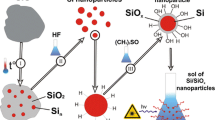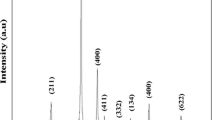Abstract
Semiconductor core/shell nanostructures have been recently attracted a great interest due to interesting properties and wide potential applications. In this work, In2O3/a-SiC core/shell nanostructure was successfully synthesized for the first time using hot wire-assisted plasma-enhanced chemical vapor deposition technique. The crystalline structure, morphology, chemical composition, and optical properties of the deposited film were investigated by variety of characterization techniques including X-ray diffraction, field emission scanning electron microscopy, energy-dispersive X-ray spectroscopy, high-resolution transmission electron microscopy, Fourier transform infrared spectroscopy, UV–Vis–NIR spectrophotometry, photoluminescence spectroscopy (PL) and Raman scattering spectroscopy. The results verified the formation of core/shell nanostructures, crystalline In2O3 as a core and amorphous SiC as a shell, successfully. The average diameter and thickness of synthesized core and shell were 101 and 38 nm, respectively. A strong and broad room-temperature PL emission in the visible and near-infrared region was observed for the synthesized structure as a result of synergic effects. This broad band was consisted of Gaussian peaks at the wavelengths of 570, 656, 728, 763, and 842 nm. The origin of different PL peaks was discussed in the paper. The results show that the novel In2O3/a-SiC core/shell nanostructure is a good candidate for optical applications.
Graphic abstract












Similar content being viewed by others
References
M. Mazzera et al., Low-temperature In2O3 nanowire luminescence properties as a function of oxidizing thermal treatments. Nanotechnology 18(35), 355707 (2007)
S. Arooj et al., Green emission of indium oxide via hydrogen treatment. RSC Adv. 8(21), 11828–11833 (2018)
Wu, P., et al. Correlation between photoluminescence and oxygen vacancies in In2O3, SnO2 and ZnO metal oxide nanostructures. in Journal of Physics: Conference Series. 2009. IOP Publishing.
J. Liu et al., Synthesis of in2o3/carbon core-shell nanospheres and their electrochemical performance. Int. J. Electrochem. Sci 7(6), 5574–5580 (2012)
S.W. Schmitt, G. Sarau, S. Christiansen, Observation of strongly enhanced photoluminescence from inverted cone-shaped silicon nanostructures. Sci. Rep. 5, 17089 (2015)
E. Zhang et al., Synthesis and photoluminescence property of silicon carbide nanowires thin film by HF-PECVD system. Bull. Mater. Sci. 37(6), 1249–1253 (2014)
J. Adeleke et al., Photocatalytic degradation of methylene blue by ZnO/NiFe2O4 nanoparticles. Appl. Surf. Sci. 455, 195–200 (2018)
A. Shanmugasundaram et al., Realizing synergy between In2O3 nanocubes and nitrogen-doped reduced graphene oxide: an excellent nanocomposite for the selective and sensitive detection of CO at ambient temperatures. ACS Appl. Mater. Interfaces. 9(37), 31728–31740 (2017)
L. Sun et al., High temperature gas sensing performances of silicon carbide nanosheets with an n–p conductivity transition. RSC .ances 8(25), 13697–13707 (2018)
B. Li et al., A novel superhydrophobic coating consisting of SiC nanowires. Mater. Res. Express 6(10), 105094 (2019)
Y. Cao et al., Three-dimensional ultrathin In 2 O 3 nanosheets with morphology-enhanced activity for amine sensing. RSC Adv. 5(74), 60541–60548 (2015)
D. Wu et al., High throughput tip-less electrospinning via a circular cylindrical electrode. J. Nanosci. Nanotechnol. 10(7), 4221–4226 (2010)
S. Roso et al., Synthesis of single crystalline In 2 O 3 octahedra for the selective detection of NO 2 and H 2 at trace levels. J. Mater. Chem. C 4(40), 9418–9427 (2016)
J. Liu et al., Synthesis of in2o3/carbon core-shell nanospheres and their electrochemical performance. Int. J. Electrochem. Sci. 7, 5574–5580 (2012)
D. Kilymis, C. Gérard, L. Pizzagalli, Ductile deformation of core-shell Si-SiC nanoparticles controlled by shell thickness. Acta Mater. 164, 560–567 (2019)
W. Hao et al., Core-shell and hollow particles of carbon and sic prepared from hydrochar. Materials 12(11), 1835 (2019)
X. Luo et al., Synthesis and photoluminescence property of silicon carbide nanowires via carbothermic reduction of silica. Nanoscale Res. Lett. 5(1), 252 (2010)
X. Wang et al., Preparation of In2O3 thin film and the study of gas sensitivity to ethanol. Integr. Ferroelectr. 199(1), 58–68 (2019)
G. Cai et al., Visible-blind UV detector based on water-gated thin film transistor with In2O3 channel grown by metal–organic chemical vapor deposition. Jpn. J. Appl. Phys. 57(11), 110301 (2018)
I.N. Reddy et al., Structural, optical and XPS study of thermal evaporated In2O3 thin films. Materials Research Express 4(8), 086406 (2017)
B.T. Goh, S.A. Rahman, Study of the growth, and effects of filament to substrate distance on the structural and optical properties of Si/SiC core–shell nanowires synthesized by hot-wire chemical vapor deposition. Mater. Chem. Phys. 147(3), 974–981 (2014)
J. Li et al., Synthesis, characterization and field emission properties of SiC nanowires prepared by chemical vapor reaction. Vacuum 146, 87–92 (2017)
F.S. Tehrani, Transformation from amorphous to nano-crystalline SiC thin films prepared by HWCVD technique without hydrogen dilution. Bull. Mater. Sci. 38(5), 1333–1338 (2015)
V. Bhimasingu et al., Influence of target grit count and sintering temperature on pulsed laser deposition of SiC thin films. Int. J. Adv. Manuf. Technol. 84(5–8), 769–776 (2016)
E.A. Filatova, D. Hausmann, S.D. Elliott, Understanding the mechanism of SiC plasma-enhanced chemical vapor deposition (PECVD) and developing routes toward SiC atomic layer deposition (ALD) with density functional theory. ACS Appl. Mater. Interfaces. 10(17), 15216–15225 (2018)
Y. Xu et al., Microstructure and properties of ZrC-SiC multi-phase coatings prepared by thermal evaporation deposition and an in-situ reaction method. Surf. Coat. Technol. 349, 797–806 (2018)
Y. He et al., Structural properties and preparation of Si-rich Si1− xCx thin films by radio-frequency magnetron sputtering. Appl. Surf. Sci. 363, 477–482 (2016)
Tehrani, F.S., H.R. Ahmadian, and M. Aliannezhadi, Hydrothermal synthesis and characterization of WO 3 nanostructures: Effect of reaction time. Materials Research Express, 2020.
H. Ahmadian, F.S. Tehrani, M. Aliannezhadi, Hydrothermal synthesis and characterization of WO3 nanostructures: effects of capping agent and pH. Mat. Res. Express 6(10), 105024 (2019)
M.A.A. Rahman et al., Multi-phase structured hydrogenated amorphous silicon carbon nitride thin films grown by plasma enhanced chemical vapour deposition. J. Alloy. Compd. 721, 70–79 (2017)
S.K. Chong et al., Structure deformation of indium oxide from nanoparticles into nanostructured polycrystalline films by in situ thermal radiation treatment. Nanoscale Res. Lett. 8(1), 1–9 (2013)
S. Mukherjee et al., Defect induced structural inhomogeneity, ultraviolet light emission and near-band-edge photoluminescence broadening in degenerate In2O3 nanowires. Nanotechnology 29(17), 175201 (2018)
S.K. Chong et al., Structural and photoluminescence investigation on the hot-wire assisted plasma enhanced chemical vapor deposition growth silicon nanowires. J. Lumin. 132(6), 1345–1352 (2012)
Kim, H., et al., Synthesis, structure, photoluminescence, and raman spectrum of indium oxide nanowires. Acta Phys. Pol. A, 2011. 119(2), 143.
M. Jothibas et al., Study on structural and optical behaviors of In 2 O 3 nanocrystals as potential candidate for optoelectronic devices. J. Mater. Sci.: Mater. Electron. 26(12), 9600–9606 (2015)
J.A.R. Ramón et al., Morphology and defect evolution in vapor-grown In2O3: Sn micro-/nanoparticles. Mater. Sci. Semicond. Process. 40, 943–953 (2015)
T. Bielz et al., Hydrogen on In2O3: reducibility, bonding, defect formation, and reactivity. J. Phys. Chem. C 114(19), 9022–9029 (2010)
R. Reshmi Krishnan et al., Properties of Au incorporated In2O3 films. Mater. Sci. Semicond. Process. 93, 134–147 (2019)
S. Sorieul et al., Raman spectroscopy study of heavy-ion-irradiated α-SiC. J. Phys. Condens. Matter 18(22), 5235 (2006)
F.S. Tehrani, M. Fakhredin, M.J. Tafreshi, The optical properties of silicon carbide thin films prepared by HWCVD from pure silane and methane under various total gas partial pressure. Mater. Res. Express 6(8), 086469 (2019)
J. Tauc, F. Abeles, Optical Properties of Solids (North-Holland, 1972).
T. Tomita et al., The origin of n-type conductivity in undoped In 2 O 3. Appl. Phys. Lett. 87(5), 051911 (2005)
K. Yadav, B. Mehta, J. Singh, Presence of metal-oxide interface enhanced photoluminescence from In–In 2 O 3 core–shell nanorods. RSC Adv. 5(2), 1581–1586 (2015)
Z. Khatami, P. Mascher, Photoluminescence of silicon carbonitride thin films: the interdependence of post-deposition annealing and growth temperature. J. Lumin. 214, 116563 (2019)
D. Kim et al., Thermally induced silane dehydrocoupling on silicon nanostructures. Angew. Chem. 128(22), 6533–6537 (2016)
F.S. Tehrani, Influence of total gas partial pressure on the structural formation of SiC thin films deposited by HWCVD technique. J. Mater. Sci. Mater. Electron. 27(11), 11457–11462 (2016)
M.M. Khan et al., Crystallite structural, electrical and luminescent characteristics of thin films of In 2 O 3 nanocubes synthesized by spray pyrolysis. Electron. Mater. Lett. 9(1), 53–57 (2013)
Launer, P.J., Infrared analysis of organosilicon compounds: spectra-structure correlations. Silicone compounds register and review, 1987. 100.
S. Askari et al., Ultra-small photoluminescent silicon-carbide nanocrystals by atmospheric-pressure plasmas. Nanoscale 8(39), 17141–17149 (2016)
S.K. Chong et al., Effect of substrate to filament distance on formation and photoluminescence properties of indium catalyzed silicon nanowires using hot-wire chemical vapor deposition. Thin Solid Films 529, 153–158 (2013)
S.K. Chong et al., Study on the role of filament temperature on growth of indium-catalyzed silicon nanowires by the hot-wire chemical vapor deposition technique. Mater. Chem. Phys. 135(2–3), 635–643 (2012)
Y.-R. Lyu, T.-E. Hsieh, The effect of dielectric confinement on photoluminescence of In2O3-SiO2 nanocomposite thin films incorporated by nitrogen. J. Appl. Phys. 113(18), 184303 (2013)
Author information
Authors and Affiliations
Corresponding author
Rights and permissions
About this article
Cite this article
Shariatmadar Tehrani, F., Rasouli, E. & Aliannezhadi, M. Novel photoluminescent In2O3/a-SiC core/shell nanostructure synthesized by HW-assisted PECVD method. Eur. Phys. J. Plus 136, 307 (2021). https://doi.org/10.1140/epjp/s13360-021-01297-z
Received:
Accepted:
Published:
DOI: https://doi.org/10.1140/epjp/s13360-021-01297-z




